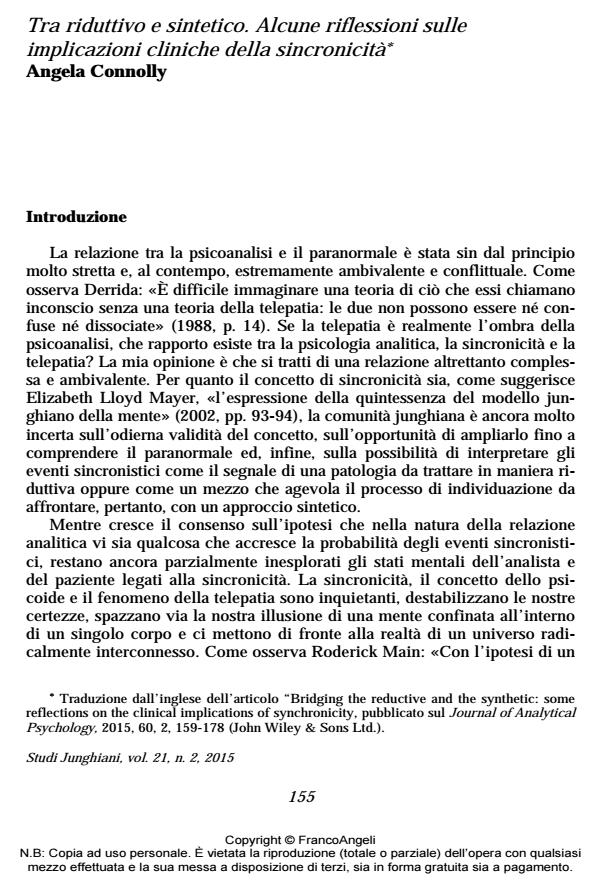Tra riduttivo e sintetico. Alcune riflessioni sulle implicazioni cliniche della sincronicità
Titolo Rivista STUDI JUNGHIANI
Autori/Curatori Angela Connolly
Anno di pubblicazione 2016 Fascicolo 2015/42
Lingua Italiano Numero pagine 21 P. 155-175 Dimensione file 107 KB
DOI 10.3280/JUN2015-042009
Il DOI è il codice a barre della proprietà intellettuale: per saperne di più
clicca qui
Qui sotto puoi vedere in anteprima la prima pagina di questo articolo.
Se questo articolo ti interessa, lo puoi acquistare (e scaricare in formato pdf) seguendo le facili indicazioni per acquistare il download credit. Acquista Download Credits per scaricare questo Articolo in formato PDF

FrancoAngeli è membro della Publishers International Linking Association, Inc (PILA)associazione indipendente e non profit per facilitare (attraverso i servizi tecnologici implementati da CrossRef.org) l’accesso degli studiosi ai contenuti digitali nelle pubblicazioni professionali e scientifiche
Quando Jung introdusse i concetti di sincronicità e di inconscio psicoide, estese la psicologia analitica ad un territorio decisamente inquietante. Nonostante il precoce interesse dimostrato da Freud, i fenomeni anomali, quali la telepatia, sono diventati un soggetto tabù in psicoanalisi. Oggi, tuttavia, si osserva un interesse crescente verso il transfert e la sincronicità, così da aprire la strada a uno scambio fruttuoso tra le differenti scuole psicoanalitiche riguardo alle loro implicazioni cliniche. L’autrice propone di esaminare alcune delle ambiguità del pensiero di Jung, al fine di chiarire la definizione della sincronicità, la relazione tra le sincronicità e gli eventi parapsicologici e il loro significato clinico. Non è ancora del tutto chiaro se tali eventi debbano essere considerati normali, un mezzo per facilitare l’individuazione, oppure come il segnale di una psicopatologia del paziente o dell’analista. Altrettanta incertezza sussiste sulle caratteristiche particolari del campo intersoggettivo che può condurre alla sincronicità. Utilizzando la tipologia delle correlazioni mente-materia elaborata da Atmanspacher e Fach e la loro distinzione tra stati mentali acategoriali e non-categoriali, l’autrice usa due vignette cliniche per illustrare i differenti stati della mente dell’analista e dell’analizzando che possono portare alla sincronicità. In particolare si focalizza sulla relazione tra rêverie e sincronicità.
Parole chiave:Telepatia, sincronicità, causalità e acausalità, ruolo degli stati della mente acategoriali e non-categoriali nella sincronicità, rêverie
- Imaginatio alchemica e nessi acausali versus terzo analitico intersoggettivo nella spiegazione dei fenomeni sincronici Stefano Fissi, in STUDI JUNGHIANI 59/2024 pp.47
DOI: 10.3280/jun59-2024oa18133
Angela Connolly, Tra riduttivo e sintetico. Alcune riflessioni sulle implicazioni cliniche della sincronicità in "STUDI JUNGHIANI" 42/2015, pp 155-175, DOI: 10.3280/JUN2015-042009